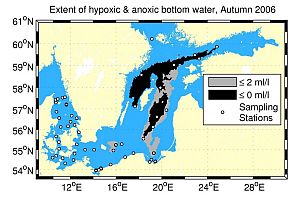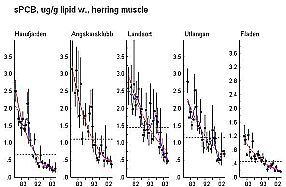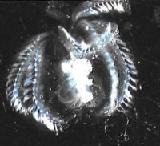HELCOM Indicator Fact Sheets for 2007
 As the environmental focal point of the Baltic Sea, HELCOM, has been assessing the sources and inputs of nutrients and hazardous substances and their effects on ecosystems in the Baltic Sea for almost 30 years. The resulting indicators are based on scientific research carried out around the Baltic Sea under the HELCOM PLC, COMBINE and MORS monitoring programmes. During the past few years, HELCOM Indicator Fact Sheets have been compiled by responsible institutions and approved by the HELCOM Monitoring and Assessment Group. The Indicator Fact Sheets for 2007 and 2006 are listed in the navigation menu on the left and older ones can be found in the Indicator Fact Sheet archive.
As the environmental focal point of the Baltic Sea, HELCOM, has been assessing the sources and inputs of nutrients and hazardous substances and their effects on ecosystems in the Baltic Sea for almost 30 years. The resulting indicators are based on scientific research carried out around the Baltic Sea under the HELCOM PLC, COMBINE and MORS monitoring programmes. During the past few years, HELCOM Indicator Fact Sheets have been compiled by responsible institutions and approved by the HELCOM Monitoring and Assessment Group. The Indicator Fact Sheets for 2007 and 2006 are listed in the navigation menu on the left and older ones can be found in the Indicator Fact Sheet archive.
Changing seasons
The sea surface temperature in 2006 was characterized by comparatively warm months in July, Octobers and Decembers and the annual average for 2006 was the warmest year of the period 1990-2006. The months February - May were comparatively cold, however. The seasonal variation of the wave climate in the Baltic Sea, Kattegat and Skagerak in 2006 was rather typical and no extreme events were measured.
The ice season 2006-2007 was very late, short and mild in terms of ice extent. The largest ice cover, 139,000 km², was reached on the 23rd of February, ice breaking up was about a week earlier than normal in most waters and on 25th May the Baltic Sea was ice free.
Life pulsates according to water inflows
 The present state of the Baltic Sea is not only the result of anthropogenic pressures but is also influenced by hydrographic forces such as water exchange between the Baltic Sea and the North Sea. After the major Baltic inflow in January 2003, which renewed most of the deep water in the Baltic Sea, a new stagnation period started in 2004 for the deep basins of the Baltic. The period afterwards is characterized by low inflow, and, except in the southern Baltic, the stagnation period lasting since 2004/2005 is strengthening further.
The present state of the Baltic Sea is not only the result of anthropogenic pressures but is also influenced by hydrographic forces such as water exchange between the Baltic Sea and the North Sea. After the major Baltic inflow in January 2003, which renewed most of the deep water in the Baltic Sea, a new stagnation period started in 2004 for the deep basins of the Baltic. The period afterwards is characterized by low inflow, and, except in the southern Baltic, the stagnation period lasting since 2004/2005 is strengthening further.
Hydrogen sulphide exists in a large area of the East Gotland Basin, and below 70 metres in the West Gotland Basin and Northern Baltic Proper. The deep anoxic water even extends up into the Gulf of Finland. This deep water, however, does not make it over the sill into the Gulf of Bothnia and therefore, despite its depth, the Åland Sea remains well oxygenated, even during autumn.
The Baltic Sea continues to suffer the impacts of human activities
 Baltic Sea habitats and species are threathened by eutrophication and elevated amounts of hazardous substances as a result of decades of human activities in the sea and its surrounding catchment area.
Baltic Sea habitats and species are threathened by eutrophication and elevated amounts of hazardous substances as a result of decades of human activities in the sea and its surrounding catchment area.
The inputs of some hazardous substances to the Baltic Sea have been reduced considerably over the past 20 to 30 years. In particular discharges of heavy metals have decreased. The significant proportion of heavy metals enter the Baltic Sea via rivers or as direct discharges: 47% for lead, 78% for mercury and 87% for cadmium. The remaining share of inputs is mainly from atmospheric deposition of these heavy metals. Dioxin emissions to the air from the Baltic coastal states have decreased by 24% during the period 1994-2005, whereas the atmospheric depositions of dioxins to the Baltic Sea during the same period has decreased by up to 50%.
A range of anthropogenic activities contirbute to significant nutrient inputs to the sea, which enter the sea either via runoff and riverine input or through direct discharges. Although nutrient inputs from point sources such as industries and municipalities have been cut significantly, the total input of nitrogen to the Baltic Sea is still almost a million tonnes per year, of which approximately 25% enters as atmospheric deposition on the Baltic Sea and 75% as waterborne inputs. The total input of phosphorus to the Baltic Sea in 2005 was ca 29,000 tonnes and entered the Baltic Sea mainly as waterborne input with the contribution of atmospheric deposition being only 1-5 % of the total. The main source of nutrient inputs is agriculture.
The 2005 waterborne loads for nitrogen and phosphorus were in most countries at the same level as in the previous year because the riverine runoff was almost equal to the runoff in 2004. Compared with the 10 year (1996-2005) average, both nitrogen (-5%) and phosphorus (-11%) waterborne loads in 2005 were lower, and most probably reflect the implementation of load reduction measures in the catchment area. Annual emissions of nitrogen from the HELCOM Contracting Parties were lower in 2004 than in 1995. Emissions from outside the Baltic Sea region add to the nitrogen loads entering the Baltic, as do emissions from the ships. In 2005, 16% of nitrogen oxides (NOx) emissions from international shipping traffic were deposited to the Baltic Sea. Mainly because of interannual changes in meteorology, no significant temporal pattern in nitrogen depositions to the Baltic Sea and its sub-basins can be detected for the period 1995-2000. Nevertheless, a clear decline after the year 2000 can be observed, with reductions of 17%, 13% and 15% in depositon of oxidized, reduced and total nitrogen, respectively, between 1995 and 2005.
Eutrophication intensifies phytoplankton blooms
 Eutrophication is the result of excessive nutrient inputs and is an issue of major concern almost everywhere around the Baltic Sea area. The satellite-derived chlorophyll-like pigments* in the Baltic Sea are clearly higher than in the Skagerrak and North Sea. The average biomass production has increased by a factor of 2.5 leading to decreased water clarity, exceptionally intense algal blooms, more extensive areas of oxygen-depleted sea beds as well as degraded habitats and changes in species abundance and distribution.
Eutrophication is the result of excessive nutrient inputs and is an issue of major concern almost everywhere around the Baltic Sea area. The satellite-derived chlorophyll-like pigments* in the Baltic Sea are clearly higher than in the Skagerrak and North Sea. The average biomass production has increased by a factor of 2.5 leading to decreased water clarity, exceptionally intense algal blooms, more extensive areas of oxygen-depleted sea beds as well as degraded habitats and changes in species abundance and distribution.
Annual integrated rates for sedimentation of organic matter** in the Gotland Sea have not show significant trends between 1995 and 2003. The bacterioplankton growth rate in the deep waters of the Gulf of Bothnian suggests at least good conditions in terms of oxygen consumption during the past decade. However, decrease in water clarity has been observed in all Baltic Sea sub-regions over the last one hundred years, with it being most pronounced in the Northern Baltic Proper and the Gulf of Finland.
The chlorophyll a concentration exceeded 3mg m-3 for more than 60% of the days during the summer period 2006 (June-September) in the Arkona, Bornholm, Easter Gotland and Northern Gotland Basins and Gulf of Riga and Finland. Patterns of dissolved inorganic nutrients in the winter nutrient pool possibly reflect reductions in nutrient inputs in the 1990's as well as the high rainfall and run-off experienced at the beginning of 2007. DIN concentrations remain below the 1993 - 2002 average, except in the Belt Sea, Kattegat and in southern Swedish coastal waters and DIP concentrations remain high in the Baltic Proper. The natural Baltic outflow through the Sound and Belt Sea has also led to higher DIP levels even in the eastern Kattegat.
No rising trend can be detected in spring blooms from 1992 to 2007 in the Gulf of Finland, the northern Baltic Proper or the Arkona Basin. However, in 2007, the spring bloom in the the Gulf of Finland occurred unusually early and was more intensive than during the previous year, but close to the ten-year average.
Since 1997, cyanobacteria were most abundant in 1999 and 2000. In the consecutive years the abundance showed large variation. In 2006, the index for toxic Nodularia spumigena rank based abundance was almost at the same level as in the previous five years, while Aphanizomenon flos-aquae showed a minor increase during the year 2006 in comparison to the previous year. In the summer of 2007, however, the normalized index for cyanobacteria bloom intensity, duration and extent were the lowest recorded during the time period 1997-2007. Nevertheless, blooms were detected in most parts of the Baltic region, with the exception of the Bay of Bothnia. The low incidence of blue-green algal blooms during the summer of 2007 is mainly the result of unfavorable weather conditions for cyanobacteria. Cold, windy and rainy weather conditions prevailed and prevented formations of surface accumulations of cyanobacteria.
Heavy metals and organic pollutant still persistent in marine environment
 Despite the considerable reductions in the inputs of some hazardous substances to the Baltic Sea, the concentrations of heavy metals and organic pollutants in sea water are still several times higher in the Baltic Sea compared to waters of the North Atlantic.
Despite the considerable reductions in the inputs of some hazardous substances to the Baltic Sea, the concentrations of heavy metals and organic pollutants in sea water are still several times higher in the Baltic Sea compared to waters of the North Atlantic.
Concentrations of contaminants in fish vary according to substance, species and location. Whereas there is no common trend in mercury concentrations, in general, the concentrations of cadmium, lead, PCBs and lindane have decreased. Dioxins show declining trends due to measures taken to reduce emissions between 1969 and 1985 but after that, this decline has ceased, contrary to e.g. PCBs. As for the concentrations of flame retardants, HBCD, a significant increase of about 3% per year can be observed in Guillemot eggs while no trend can be seen for HBCD in herring muscle during the monitored time period, 1999-2005.
Overall the levels of radioactivity in the Baltic Sea water and biota have shown declining trends since the Chernobyl accident in 1986, which caused significant fallout over the area. In general, the discharges of radionuclides from local nuclear power plants into the Baltic Sea have shown decreasing trends during the last decade and contribute less than 1% of total inputs of radioactivity into the Baltic Sea. Radioactivity is now slowly transported from the Baltic Sea to the North Sea via Kattegat. The amount of caesium-137 in Baltic Sea sediments however has remained largely unchanged, with highest concentrations in the Bothnian Sea and the Gulf of Finland.
Ecosystem effects
Variables such as climate-induced changes in temperature and salinity, fishing pressure, as well as variations in bottom water oxygen conditions (climate and eutrophication induced) have significant impacts on ecosystem structure.
In 2005, marine phytoplankton species Cerataulina pelagica, Chaetoceros brevis and Dactyliosolen fragilissimus penetrated far into the Baltic Proper and up to the Lithuanian coast in late autumn, possibly indicating warm water inflows that cannot be identified on the basis of salinity measurements. Statistical analysis reveal opposite biomass trends for some taxonomical groups of phytoplankton (cyanobacteria, dinophytes, prasinophytes and chlorophytes) in different sub-basins; for example cyanobacteria decreased in the Baltic Proper during last decade, but increased in the Bothnian Sea.
Despite a lack of consistency, high water temperatures during growth seasons in recent years have possibly affected coastal fish communities in Bothnian Sea. This is reflected as an increased recruitment success and/or increased individual growth rate of dominating, warm water dwelling, species. Furthermore, the effects of changes in fishing pressure were observed in Gulf of Riga and in southern Baltic Proper. In the Gulf of Riga a high exploitation rate of piscivorous fish during mid 1990’s was clearly recognised and in the Baltic Proper, flounder (Platichthys flesus), has increased during the period possibly due to population recovery after a previous high exploitation rate.
The degenerating state of the the Baltic Sea affects marine life in many ways. Macrobenthic communities** have been severely degraded by increased eutrophication throughout the Baltic Proper and the Gulf of Finland and are below the longterm averages. Populations of the amphipod Monoporeia affinis have crashed in the Gulf of Bothnia and the invasive polychaete Marenzelleria viridis has spread.
Impacts of shipping on the marine environment
 An increase in the number of maritime transportation during the past decade has increased the potential for an increased numbers of illegal oil discharges. Furthermore, emissions of nitrogen oxides from shipping contribute to the eutrophication of Baltic Sea. Increasing maritime traffic also plays a role in the introduction of alien species into the the marine environment. The most recent invader in the Baltic Sea is the American comb jelly, which has earlier been transferred unintentionally via ballast waters to the Black and Caspian Seas. It was found for the first time in the southern Baltic in autumn 2006 and has now spread further north and was found abundant in August and September 2007 in the deeps of the Bothnian Sea, the northern Baltic Proper and the Gulf of Finland.
An increase in the number of maritime transportation during the past decade has increased the potential for an increased numbers of illegal oil discharges. Furthermore, emissions of nitrogen oxides from shipping contribute to the eutrophication of Baltic Sea. Increasing maritime traffic also plays a role in the introduction of alien species into the the marine environment. The most recent invader in the Baltic Sea is the American comb jelly, which has earlier been transferred unintentionally via ballast waters to the Black and Caspian Seas. It was found for the first time in the southern Baltic in autumn 2006 and has now spread further north and was found abundant in August and September 2007 in the deeps of the Bothnian Sea, the northern Baltic Proper and the Gulf of Finland.
*These Indicator Fact Sheets have not been updated since October 2006.
**These Indicator Fact Sheets have not been updated since October 2005.
Information on the long-term varaitions in the Baltic marine environment can be found in:
Atmospheric Supply of Nitrogen, Lead, Cadmium, Mercury and Dioxins/Furans to the Baltic Sea in 2005 (2007)
Climate Change in the Baltic Sea Area - HELCOM Thematic Assessment 2007 (2007)
Heavy metal pollution to the Baltic Sea in 2004 (2007)
Atmospheric Supply of Nitrogen, Lead, Cadmium, Mercury and Dioxins/Furans to the Baltic Sea in 2004 (2006)
Assessment of Coastal Fish in the Baltic Sea (2006)
Nutrient Pollution to the Baltic Sea in 2000 (2005)
Airborne nitrogen loads to the Baltic Sea (2005)
Evaluation of transboundary pollution loads (2005)
Dioxins in the Baltic Sea (2004)
The Fourth Baltic Sea Pollution Load Compilation (PLC-4) (2004)
The Baltic Marine Environment 1999-2002 (2003)
Radioactivity in the Baltic Sea 1992-1998 (2003)
Fourth Periodic Assessment of the State of the Marine Environment of the Baltic Sea Area, 1994-1998 (2003)
Fourth Periodic Assessment of the State of the Marine Environment of the Baltic Sea, 1994-1998; Executive Summary (2001)
List of 2007 HELCOM Indication Fact Sheets
Water exchange between the Baltic Sea and the North Sea, and conditions in the deep basins
Hydrography and oxygen in deep basins
Total and regional Runoff to the Baltic Sea
Water transparency in the Baltic Sea between 1903 and 2006
Development of Sea Surface Temperature in the Baltic Sea in 2006
Wave climate in the Baltic Sea 2006
Emissions from the Baltic Sea shipping
Nitrogen emissions to the air in the Baltic Sea area
Atmospheric nitrogen depositions to the Baltic Sea during 1995-2005
Waterborne loads of nitrogen and phosphorus to the Baltic Sea
Spatial distribution of the winter nutrient pool
Cyanobacterial blooms in the Baltic Sea
Temporal and spatial variation of dissolved nutrients and chlorophyll a in the Baltic Sea in 2006
Atmospheric emissions of heavy metals in the Baltic Sea region
Atmospheric depositions of heavy metals on the Baltic Sea
Waterborne loads of heavy metals to the Baltic Sea
Atmospheric emissions of PCDD/Fs in the Baltic Sea region
Atmospheric depositions of PCDD/Fs on the Baltic Sea
Heavy metals in Baltic Sea water, 1993-2006
Temporal trends in contaminants in Herring in the Baltic Sea in the period 1980-2005
Cadmium concentrations in fish liver
Lead concentrations in fish liver
Mercury concentrations in fish muscle
TCDD-equivalents in herring muscle and guillemot egg
PCB concentrations in fish muscle
Hexabromocyclododecane (HBCD) concentrations in herring muscle and Guillemot egg
Concentrations of the artificial radionuclide caesium-137 in Baltic Sea fish and surface waters
Total amounts of the artificial radionuclide caesium -137 in Baltic Sea sediments
Liquid discharges of Cs-137, Sr-90 and Co-60 into the Baltic Sea from local nuclear installations
Shifts in the Baltic Sea summer phytoplankton communities in 1992-2006
Temporal development of Baltic coastal fish communities and key species
The recent aquatic invasive species American comb jelly Mnemiopsis leidyi in the Baltic Sea
Ecosystem regime state in the Baltic Proper, Gulf of Riga, Gulf of Finland, and the Bothnian Sea
Last updated: 30.10.2007

